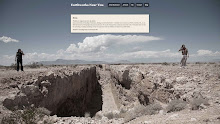Rebecca Solnit is one of my favorite authors who writes about the Western landscape, the influences of photography, and Richard Misrach who had a profound impact on me my first semester of graduate school. Here are two of his photographs: Jupiter at Massacre Lake and Polaris Over Lake Meade and below a few highlights from Solnit's "Excavating the Sky."

"Stars are made of flaming gases, but constellations are made of stories. Stars are the things themselves, constellations the way we connect those things to each other and ourselves through words, names, stories. Every culture has read constellations into the night sky, perhaps because we remember things and beings by their names; and calling people, places, things by name is how we establish a relationship to them at best, claim them as property at worst. Constellations connect the stars to each other, but in a way that no longer speaks of stars but of animals, goddesses and heroes. Constellations are an essential metaphorical construct - or one might say that metaphor is an art of making constellations, of constellating."
"Seven stars slightly west of due north conjoined make something wholly different than stars, a dipper and the dipper makes the sky navigable - but it also makes the sky offer up a metaphysical drink and a recognizable earthly object. Runaway slaves called the constellation "the drinking gourd" and followed it north. Farther west, the Zuni also saw it as a drinking gourd, but the Hopi saw it as a 'star thrower,' the Northern Paiute and Western Shoshone as a rabbit net, the Chumash as seven boys who became wild geese, the Isleta Pueblo as a cradle, and the Tohono O'odham as a cactus-gathering hook. The same stars make up entirely different maps."

"Clouds drift, stars rotate, and sometimes the shortest distance between two places leaves out the most important sites."

No comments:
Post a Comment